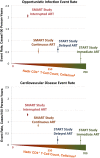Immunologic Biomarkers, Morbidity, and Mortality in Treated HIV Infection
- PMID: 27625430
- PMCID: PMC5021241
- DOI: 10.1093/infdis/jiw275
Immunologic Biomarkers, Morbidity, and Mortality in Treated HIV Infection
Abstract
Despite marked improvements in the modern treatment era, human immunodeficiency virus (HIV)-infected individuals, particularly those who initiated antiretroviral therapy (ART) at advanced disease stages, continue to have increased age-related morbidity and mortality, compared with the general population. Immune activation and inflammation persist despite suppressive ART and predict many of these morbidities. The goal of this review is to examine the evidence suggesting a link between the persistent inflammatory state and morbidity and mortality in this setting, to describe the impact of early ART initiation on these factors, and to highlight important unanswered questions for the field. We also advance a hypothesis to explain why some morbidities-and their root inflammatory drivers-may be prevented more than others by early ART initiation.
Keywords: HIV-1 infection; antiretroviral therapy; biomarkers; immune activation; inflammation; morbidity; mortality.
© The Author 2016. Published by Oxford University Press for the Infectious Diseases Society of America. All rights reserved. For permissions, e-mail journals.permissions@oup.com.
Figures


References
-
- Legarth RA, Ahlstrom MG, Kronborg G et al. . Long-term mortality in HIV-Infected individuals 50 years or older: a nationwide, population-based cohort study. J Acquir Immune Defic Syndr 2016; 71:213–8. - PubMed
-
- Hunt PW, Martin JN, Sinclair E et al. . T cell activation is associated with lower CD4+ T cell gains in human immunodeficiency virus-infected patients with sustained viral suppression during antiretroviral therapy. J Infect Dis 2003; 187:1534–43. - PubMed
-
- Lederman HM, Williams PL, Wu JW et al. . Incomplete immune reconstitution after initiation of highly active antiretroviral therapy in human immunodeficiency virus-infected patients with severe CD4+ cell depletion. J Infect Dis 2003; 188:1794–803. - PubMed
Publication types
MeSH terms
Substances
Grants and funding
LinkOut - more resources
Full Text Sources
Other Literature Sources
Medical

